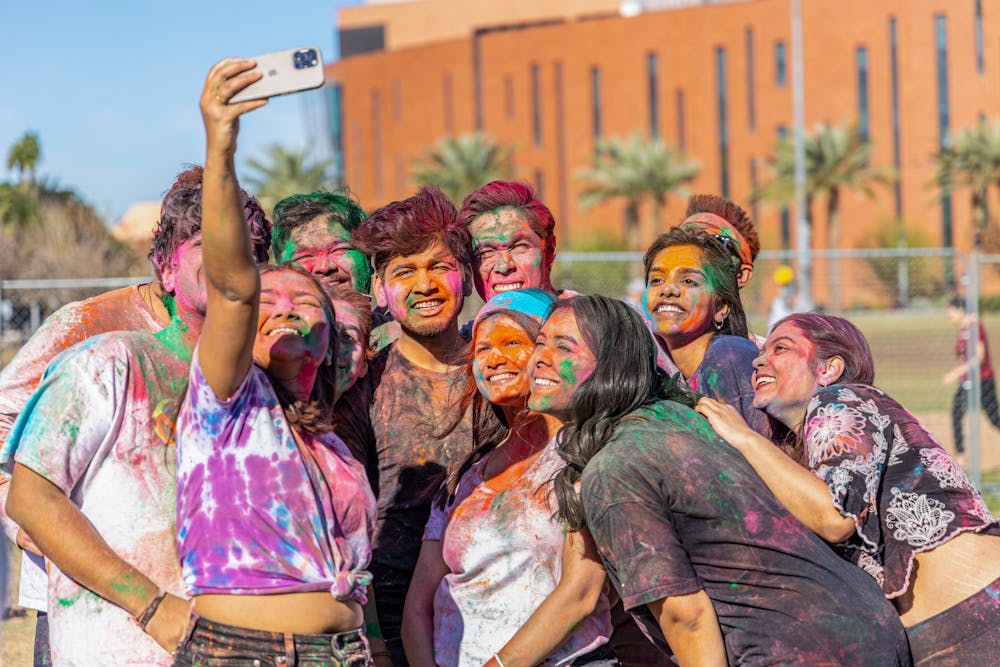When I walk around campus, I don’t always hear English. It's often languages from different corners of the world. But one language always stands out to me immediately: Hindi. It's not just because I speak it; it's because Hindi is the official language of my native country, India.
Although technically an immigrant, I consider myself a first-generation Indian American. I don’t remember much of my life in India. When my family and I moved to the U.S. when I was three, I was fluent in my mother tongue, Malayalam, and communicated exclusively in it until I had to adapt to fit into English-speaking America.
I still kept my mother tongue with me, but parts of it were sacrificed to fit myself into the American mold I was supposed to conform to. Although I know that I am Indian and celebrate my Indian heritage through holidays, traditions and language, I never feel as if I am Indian enough.
I know I'm not alone. For many other Indian Americans, ASU's large international population reminds them of what it is to be purely Indian and what being Indian American means.
"I consider myself Indian American," said Krisha Agarwal, a freshman studying biomedical engineering. "Indian comes first, and American comes second."
Agarwal's parents immigrated from Pune, India, before she was born in Chandler. She said has spent her life growing up with two identities.
Being Indian American requires the understanding that it is never one culture that we are carrying; it's two. This duality is often showcased in different ways, but for some, it manifests through their proficiency in their mother tongue.
"I’m very fluent in my mother tongue of Malayalam," Arpana Ajith, a freshman studying biochemistry and microbiology, said. "I know how to read and write, as my parents taught me."
For many first-generation students, parents serve as the catalysts of culture. Since they grew up in their home country, they have the discretion to pass on the ways of their ancestors to their children. It may not always be through the mother tongue; sometimes it takes other forms, such as art.
For Aria Raman, a freshman studying biomedical science, her connection to her home country is through learning the traditional dance of her parents' home state of Tamil Nadu, an art form called "Bharatanatyam."
Furthermore, for Indian American students, religion may play a large role in facilitating their connection to their heritage.
"Religion-wise, I pray every day," Raman said. "It makes me feel better that I’m still connecting myself to my heritage and not letting that part go."
Additionally, our cultural connection may be expressed through the food we eat and the movies we watch. Ajith talked about how she always watches new Malayalam movies to stay up-to-date on popular culture.
"It helps me connect to the culture and society that is India," Ajith said.
However, despite all of our efforts, there is always something limiting us from labeling ourselves as purely "Indian." I'm constantly reminded of this every day as I see actual Indians across campus speaking their native tongues and bringing parts of their culture here. It reminds me of my own parents and how their culture continues to shine bright, yet mine seems a bit diminished.
"A lot of things we do as a family have become Americanized," Raman said. "I don't feel the same as kids that grew up in India because I couldn’t do those things as a kid."
Learning what defines our culture always has a ceiling. As Agarwal puts it, attending an American school and learning American history limits our knowledge about our own culture.
It goes both ways. "We already have that preconceived notion to prove ourselves as Indian," said Ajith. "It brings pressure to Indian (American) students in general. At the end of the day, we're ultimately going to be American. But in the American sphere, we're always going to be Indian."
It's a delicate mix of blending two identities. One is a product of our roots and what we look like, while the other is a product of our environment and upbringing. With the brilliant population of Indian international students at ASU, it almost seems we’re trying to separate ourselves from within.
"I'm certain that if I were to apply for a job interview or talk to other students, they would say, 'I thought you were international at first,'" said Ajith. "International students have made a name for themselves."
As Indian American students grapple with their identity, we also acknowledge the immense privilege of growing up in America. Raman talked about having the best possible life in America and recognized the tremendous opportunity she was given to grow up here.
ASU's sizeable international student population inspires Indian Americans to continue embracing their home culture while appreciating the American part of them. "I'll always take pride in celebrating (both cultures) with no shame," Agarwal said.
We are more than Indian enough. We are first-generation Indian Americans. We're proud of the lifestyle our parents gave us and the way we've adapted to being the product of our heritage and our environment.
Edited by Walker Smith, Sadie Buggle, Angelina Steel and Grace Copperthite.
Reach the reporter at gachatht@asu.edu.
Like The State Press on Facebook and follow @statepress on X.
Gokul Achaththekoot is a junior majoring in actuarial science at ASU. He is involved with on-campus sketch comedy, and enjoys learning more about the community and culture of ASU. This is his 5th semester at The State Press, having served on The Echo as a part-time reporter in all his semesters here.




